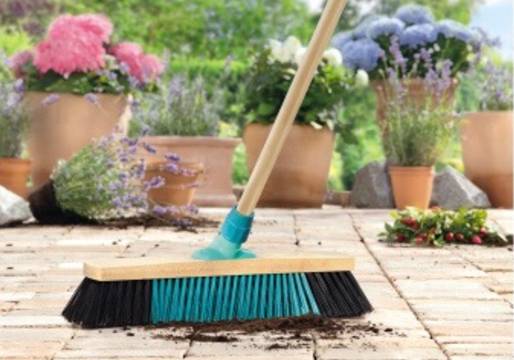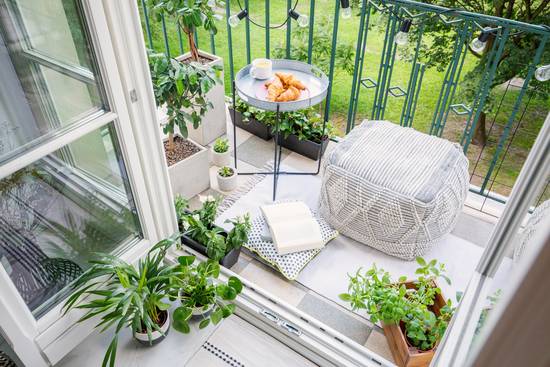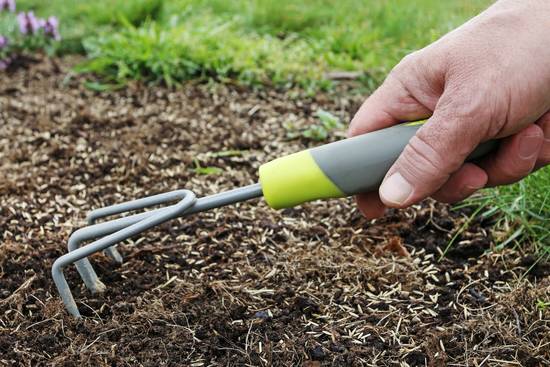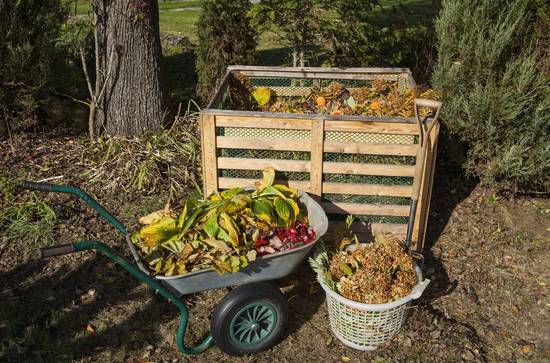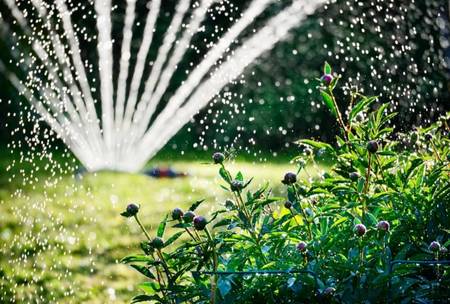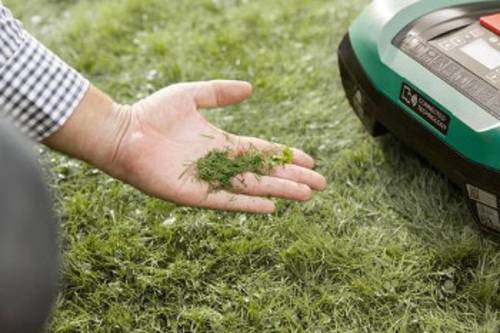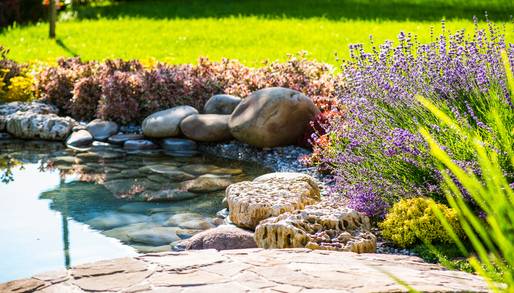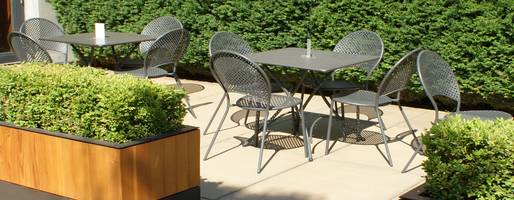Garden maintenance in spring » Getting the garden ready for spring
Published: 19.04.2021 | Reading time: 9 minutes
This text is machine translated.
Having your own garden is the greatest luxury of our time. It demands what is most precious to us and of which we always have too little: Time, attention and space. It is a green living room, a place to grow fruit and vegetables and a playground all in one.
When the days get longer again in spring and the first rays of sunshine brighten up the day, all amateur gardeners get itchy fingers and the desire to work in the garden increases. You can hear hammering and sawing everywhere outside. Lawns are being diligently scarified, fences and furniture are being cleaned or freshly painted. The garden is getting ready for spring.
We give you some tips and ideas on how you too can get your garden ready for spring.
The first step should be a tour of your own garden.
Check which plants and objects have survived the winter without damage from frost, moisture and wind and which have not.
Check the soil, perennials, fruit trees, shrubs and plants very carefully.
Pay particular attention to your potted plants. They are particularly susceptible to damage from the cold in winter.
Start by cleaning the patio, balcony and garden paths. Check where moss, soil residue, leaves and weeds need to be removed.
If removing weeds and sweeping the floor does not achieve complete cleaning, then use a high-pressure cleaner. This can also be used to quickly and easily remove stubborn dirt, such as moss and algae stuck in joints.
If necessary, wooden decking can be given a new coat of paint after cleaning.
The spring sun can be enjoyed twice as well on a freshly cleaned and well-maintained patio.
Favorite place balcony
Not everyone can enjoy their own garden, but your own balcony can also become a little oasis of well-being. You should also get it ready for spring.
Cleaning the ground and railings or privacy screen should also be a top priority here. Remove all leaves, dead plant parts and bird droppings. Check that your balcony boxes, planters and small beds are all still serving their purpose and are in good working order.
Defective supports or cracks in the pots would otherwise quickly spoil your enjoyment. Replace damaged items and replace soil and plants if necessary.
You can also prepare your balcony for the new season with fresh paint.
As soon as you've got everything ready, you'll be much happier looking through your windows towards the balcony again - even on cooler spring days - and looking forward to a beautiful summer.
First, you should remove the remains of leaves and small wood from the beds. These belong in the compost or at the garden waste collection point. As this layer of plant remains was like a protective warm blanket, life has long since begun underneath.
For this reason, you should only work the soil in these areas lightly with a rake to loosen it up. Weeds are best plucked by hand.
In areas where life is still dormant and in beds that will later be used for self-sufficiency, it is recommended to mix the soil with organic material such as compost, straw or grass cuttings. This helps to supply the soil with nutrients.
Sustainable gardening with soil cultivation?
Plants of all kinds extract nutrients from the soil.
Even if you plant different crop rotations so that the same nutrients are not always extracted from the soil, you cannot avoid fertilizing.
Efficient and natural fertilization is also possible without the use of chemical products. Compost and manure are the fertilizers of choice.
Your advantage: beneficial insects are not driven away, but enrich your garden. They eat pests, pollinate crops and aerate the soil. They thus ensure a natural balance.
Hedges, shrubs, flowers etc. that have not already been cut back in the fall should be brought back into shape in spring at the latest.
In order not to disturb birds during the breeding season, radical pruning of shrubs and hedge plants is prohibited between March 1 and September 30 according to the Federal Nature Conservation Act. However, topiary is permitted.
To ensure that this is successful on tall trees or plants, it is best to work with hedge shears (hedge shears guide) or delimbers. More detailed information on essential gardening tools can be found in our guide. Pruning is as gentle as possible when temperatures are above zero degrees.
To keep the areas under trees and shrubs looking neat and tidy, the greenery there also needs to be trimmed. A lawn trimmer is very useful in these hard-to-reach areas. Our lawn trimmer guide will answer all your questions about this practical helper: Accurate lawn edges at the touch of a button.
If you have removed old twigs and leaf debris from your lawn after the winter and you see brown-yellow patches, bare patches or moss, then there is no need to panic.
As waterlogging, a lack of nutrients or infestation by pests cannot be avoided over the winter, this condition is completely normal.
The end of March to the beginning of May is the ideal time for a lawn treatment.
This should consist of three steps and take place after the first lawn mowing: Scarifying, reseeding and fertilizing.
Important: Mow regularly!
You can cut your lawn from March and a height of 8 cm at the latest.
In average weather conditions, the cut length should be around four centimetres high. In very hot and dry periods, a few centimeters more is good for the lawn. This protects it better from burning out.
You can find out how a robotic lawnmower can make your work easier in our guide.
As soon as you have taken your benches, chairs and tables or outdoor lounge furniture out of their winter quarters, you should clean them thoroughly.
If you use a high-pressure cleaner, your outdoor garden furniture will quickly be clean and ready for use.
Possible damage will also be easier to detect after cleaning. Wooden furniture requires additional care after cleaning.
Wood that has been exposed to wind and weather in the previous season must be re-oiled annually. A new coat of paint may also be necessary.
Garden furniture - time for something new?
If you have decided to buy new garden furniture or replace defective parts, you will be spoiled for choice online and at your local dealer. Before buying, it is important that you consider what function the furniture should fulfill and whether it suits your garden style. Only then will you be able to enjoy it for a long time and enjoy spending time outside in your garden.
Popular materials for outdoor use:
- Wood
- Steel
- Plastic
- Polyrattan
- Aluminum
The only maintenance-free material is (stainless) steel.
But furniture made of plastic, polyrattan and aluminum is also easy to care for - just soap and water.
As already mentioned, wood requires a little more care. It should be treated with wood oil every year. Mild soapy water prevents wooden furniture from turning gray too quickly.
Spring is not only the right time for garden furniture, but also for barbecues, fire bowls, hammocks and rotary dryers to leave winter storage.
Open the barbecue season
If not already done in the fall, you should check these items thoroughly for damage when setting them up, clean them and remove any rust if necessary.
Then place your barbecue on the patio so that it can be used immediately in good weather.
What could be better than enjoying sausages, steaks and grilled vegetables outdoors?
Your own garden pond
If you have been dreaming of enjoying your own pond after work for a while, we recommend our various guides on pond technology.
From pond construction to pond maintenance, you will find everything you need to know here.
A garden pond is not only beautiful to look at, it also provides an important habitat for numerous animals and plants.
For animals, it is not only a source of food and a hiding place, but also a good retreat for raising their offspring.
Lighting for home and garden, patio and balcony
When it gets dark in the evening, you can add beautiful accents to your outdoor area with the right lighting for your home and garden, patio and balcony.
Whether solar garden lights or classic battery-powered garden lights, they all give your garden a very special atmosphere.
Garden spotlights are particularly suitable for highlighting individual objects that you want to draw attention to.
These can be sculptures, trees or bushes. It is important that garden lamps are waterproof and dustproof.
Companies benefit twice over from a company garden. With professionally designed outdoor areas, an employer invests in both image and employee motivation. An investment that pays off, because a positive image has a direct impact on customer confidence and, according to studies, motivated employees are over 10% more effective.
Whether a medical practice, industrial company, media agency or office - companies present themselves to the outside world in many different ways. Buildings and the surrounding grounds are the figurehead of a company.
Company gardens are also the somewhat different trademark of a company. They stand for the fact that companies are employee and environmentally friendly and thus make a personal and ecological statement.
Depending on the choice of design style, materials and plants, the corporate identity can be continued in the outdoor area. Those who plant classically show a sense of tradition. Those who opt for unusual design ideas alongside steel and glass signal modernity and creativity.
Employees can relax, unwind and recharge their batteries in the company garden during their lunch break. This directly increases work performance and creativity. Seating groups facing each other in beautifully designed outdoor areas stand for the values of openness and communication. When the weather is nice, your employees can meet for meetings away from the office atmosphere and clear their heads at the same time.
Company gardens should be professionally laid out and maintained as required. This is the only way to ensure that they always look their best. Landscape gardeners offer everything from advice, planting and maintenance to the installation of automatic irrigation from a single source.

